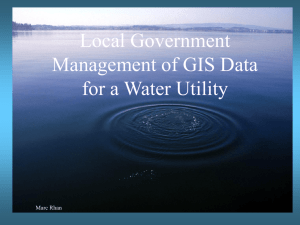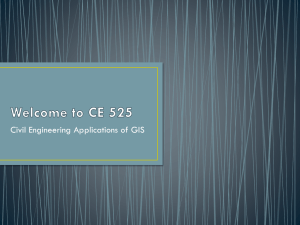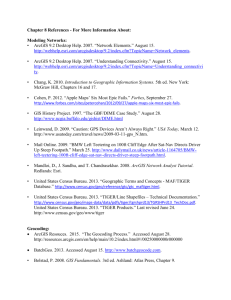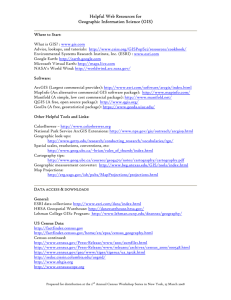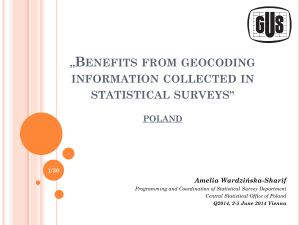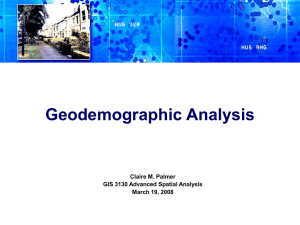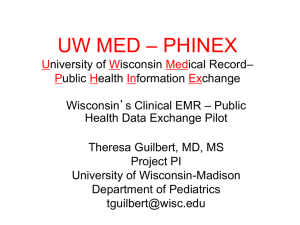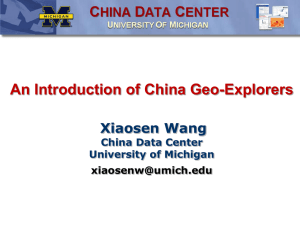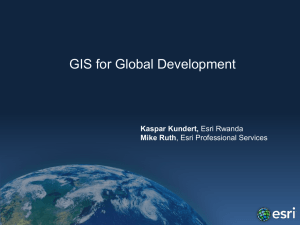Analyzing Student Geo-Demographics at Clark State Community
advertisement
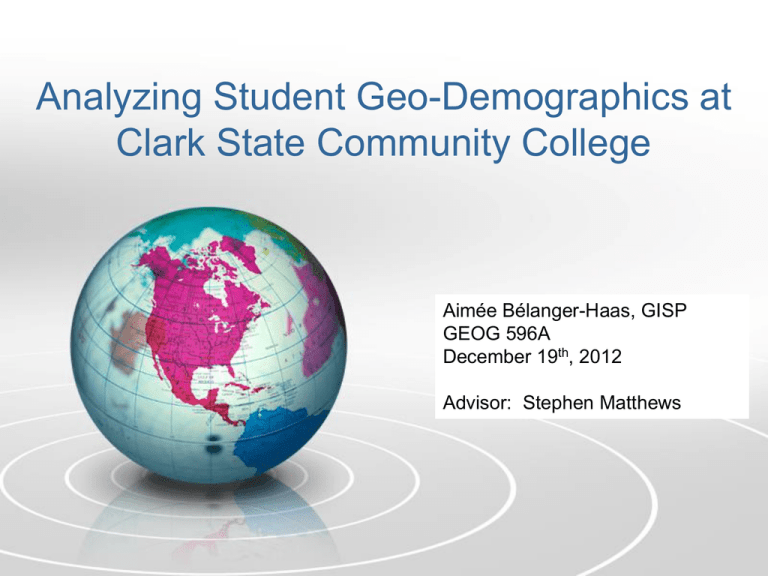
Analyzing Student Geo-Demographics at Clark State Community College Aimée Bélanger-Haas, GISP GEOG 596A December 19th, 2012 Advisor: Stephen Matthews Outline • Background • Goals and Objectives • Proposed Methodology • Anticipated Results • Timeline Clark State Community College Funding • Sources? – Alumni society – Fundraising – Government funding (changing and reducing) • A large part is generated via student tuition and recruiting students • Identifying “where” to recruit students from can be an important financial strategy Typical Clark State Student Year Total Average Enrollment Age % Male % Female % Full Time % Part Time 2012 4,977 28.2 33.8 66.2 41.1 58.9 2011 5,139 28.5 32.4 67.6 43.6 56.4 2010 4,993 28.4 34.0 66.0 45.9 54.1 Average 5,036 28.36 33.4% 66.6% 43.5% 56.5% Research Question • Based on five years of registration data, what are the demographic characteristics of a typical CSCC student? • Can other similar areas be identified to help with marketing efforts? • Other potential questions worth examining include the characteristics of students based on academic grade and major Geodemographics • Study of people according to where they live • Loosely based on the assumption of “birds of a feather flock together” • Provides the capability to predict consumer behavior based on a neighborhood classification Education is like a Business • The retail sector has fully embraced the use of geodemographics to help increase business and profits by better identifying potential customers • This same methodology can be applied for Higher Educational institutions • Both have customers (students) with addresses that can be geocoded that can help uncovering varying themes through their geodemographic profile Previous Research • Studies have been accomplished at other higher education institutions • Most have been at 4-year universities who recruit straight out of high school • Many institutions do analysis but do not reveal their methods Methodology Step 1: Acquire Student Data • Get student information from Institutional Research (IR) Student Information Address Gender Age Ethnicity Degree/Major Grade Point Average High School (if reported) SAT score (if reported) Step 2: Download Census 2010 data • Tract level (n=355) data will be downloaded to create the geodemographic segments • American Community Survey (ACS) 5-year estimates (2007-2011) data will be utilized for demographic, social, economic and housing characteristics • SF1 data will be utilized for counts Census Variables Step 3: Create Geo-demographic Segments • Segments will be created based on the combination of socioeconomic data • Exploratory Spatial Data Analysis (ESDA) will be conducted in OpenGeoDa and ArcGIS, variables will be evaluated and paired down • Census tracts will be grouped together based on similarities • Student dataset spatially joined to segments Step 4: Analyze • Identification of hot spots will be undertaken for various sub-groupings • I will use the R statistical package & the ArcGIS spatial statistics toolset. • I plan to explore the use of methods such as: – On point data: Kernel Density Analysis (KDE), as well as several functions such as Ripley's K, L, and the pair correlation function (PCF). – On area data: Spatial regression analysis to explicitly model spatial relationships Anticipated Results • Students will be classified into different geodemographic groups to help uncover areas that match target demographics • CSCC will gain a better understanding of its student’s neighborhood socioeconomic characteristics • Areas surrounding CSCC will potentially be identified and targeted marketing may occur in order to help increase enrollment Additional maps of use to the College • • • • • • • Enrollment per census tract Educational attainment and median income per census tract CPE students with total student population CPE students versus total density per school district CPE students with median family income Drive time analysis Enrollment as a percentage by census tract versus total population college aged students (market penetration) Timeline Winter 2013: – Present before IRB Board – Geocode student datasets – Download census data Spring 2013 – Process data and create Geodemographic segments – Analyze results Summer 2013 – Present at ESRI Education User Conference – Provide the CSCC with the maps and results Acknowledgments • Would like to acknowledge the following people: – Advisor: Stephen Matthews – Institutional Research: Cynthia Applin – Marketing Director: Jennifer Diestch References Adnan, M., Longley, P., Singleton, A. and Brunsdon, C. (2010). Towards Real Time Geodemographics: Clustering Algorithm Performance for Large Multidimentional Spatial Dabases. Transactions in GIS , 283-297. Batey, P. (1999). Participation in higher education: A geodemocratic perspective on the potential for further expansion in student numbers. Journal of Geographical Systems , 277-303. Crosta, P., Leinbach, T. et al (2006). Using Census Data to Classify Community College Students by Socioeconomic Status and Community College Characteristics. Community College Resource Center Research Tools , 1-12. DesJardins, S. L. (2002). An Analytical Stragegy to Assist Institutional Recruitement and Marketing Efforts. Research in Higher Education , 531-553. Hanewicz, D. C. (2012, 02 28). Geographic Information Systems and the Political Process. Retrieved 2012 17-10 from wpsa.research.pdx: http://wpsa.research.pdx.edu/meet/2012/hanewicz.pdf Krestle, J. (2004). Geodemographic target clusters: A case study. Monday Report on Retailers , 2-4. Lane, J. (2003). Studying Community Colleges and Their Students: Context and Research Issues. New Directions for Institutional Research , 51-67. Livinsgton, A. (2000, 07 16). Colleges search for applicants, with glitz and geodemographics. The Associated Press . New York. Marble, D. (1997, 07). A Model for the Use of GIS Technology in College and University Admissions Planning. Retrieved 2012 йил 01-10 from ESRI User Conference Proceedings: http://proceedings.esri.com/library/userconf/proc97/proc97/to250/pap218/p218.htm Marble, D. and Herries, J (2001). A Model for the Use of GIS Technology in College and University Admissions Planning. ESRI User Conference, San Diego California. Marble, D. (1995, 07). Applying GIS Technology to the Freshman Admissions Process. Retrieved 2012 йил 01-10 from ESRI User Conference Proceedings: http://proceedings.esri.com/library/userconf/proc95/to200/p182.html Mora, V. (2003). Applications of GIS in Admissions and Targeting Recruiting Efforts. New Directions for Institutional Research , 15-21. Read, P., Higgs, G and Taylor, G. (2005). The potential and barriers to the use of geographical information systems for marketing applications in higher education institutions. Marketing Intelligence & Planning , Volume 23, 30-42. Questions Please feel free to contact me at belanger-haasa@clarkstate.edu Aimee Belanger-Haas

